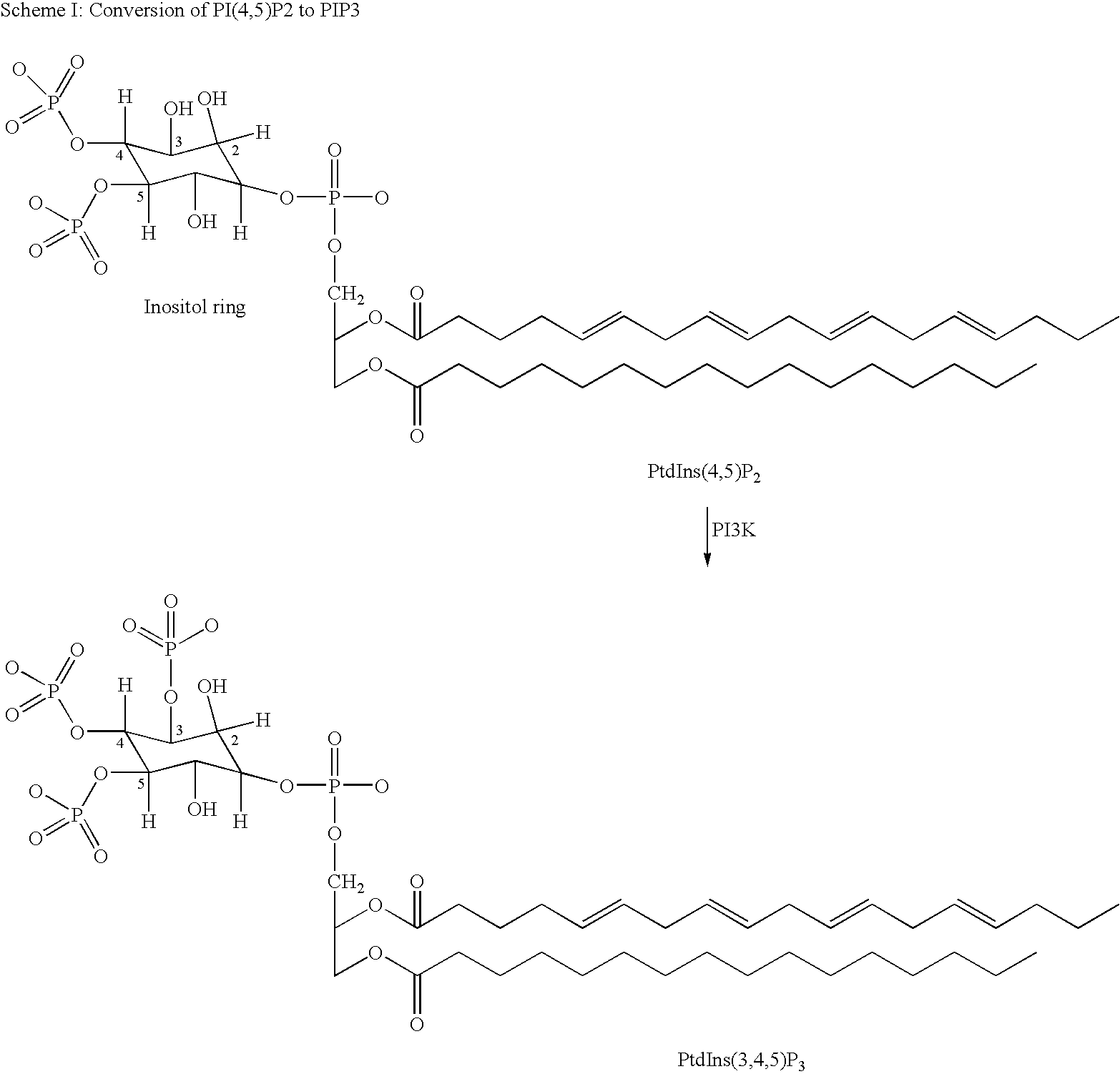Quinazoline derivatives as p13 kinase inhibitors
a technology of kinase inhibitors and derivatives, which is applied in the field of quinazoline derivatives, can solve problems such as limited expression of the enzym
- Summary
- Abstract
- Description
- Claims
- Application Information
AI Technical Summary
Benefits of technology
Problems solved by technology
Method used
Image
Examples
example 1
2-amino-5-[2-[(2-hydroxyethyl)amino]-4-(4-pyridinyl)-6-quinazolinyl]-N,N-dimethyl-3-pyridinesulfonamide
[0383]
a) (2-amino-5-bromophenyl)(4-pyridinyl)methanone
[0384]To a stirred solution of 1 N BCl3 in CH2Cl2 (100 mL, 100 mMol) was added a solution of 4-bromoaniline (12.2 g, 70.9 mMol) in tetrachloroethane (90 mL). After stirring for 10 min., (formed a fine suspension), 4-cyanopyridine (8.9 g, 85.5 mMol) and AlCl3 (13.3 g, 99.7 mMol) were added. The reaction mixture was refluxed for 4.5 h then carefully treated with aq. 3 N HCl (65 mL) dropwise through the condenser. The reaction formed a gummy precipitate (difficult stirring) that eventually became an orange suspension after continued addition of HCl. After refluxing for 1.5 h the reaction was cooled to RT, diluted with CH2Cl2 (100 mL), then extracted with aq. 1 N HCl (5×100 mL). The extracts were washed once with CH2Cl2, then made basic with 6 N NaOH (˜200 mL). The resulting fine slurry which formed was filtered off (slow) through a...
example 11
Preparation of 4-(4-pyridinyl)-6-(1H-pyrrolo[2,3-b]pyridin-5-yl)quinazoline
[0390]
a) (2-amino-5-bromophenyl)(4-pyridinyl)methanone was prepared as described in Synth. Comm. 1985, 15, 1271. MS (ES)+m / e 278 [M+H]+.
b) 6-bromo-4-(4-pyridinyl)quinazoline
[0391]To a stirred solution of (2-amino-5-bromophenyl)(4-pyridinyl)methanone (1.0 g, 3.6 mMol) in formamide (15 mL) was added 98% formic acid (0.4 mL, 10.4 mMol). The reaction was stirred and heated at 120° C. (attached a reflux condenser) for 18 h. The reaction was evaporated to dryness under vacuum, triturated with 0.5 N NaHCO3 (25 mL), filtered, washed with water, and dried under vacuum to give the title compound (0.84 g, 81%) as an off-white solid; MS (ES)+m / e 286.0 [M+H]+.
c) 4-(4-pyridinyl)-6-(1H-pyrrolo[2,3-b]pyridin-5-yl)quinazoline
[0392]A slurry of 6-bromo-4-(4-pyridinyl)quinazoline (113 mg, 0.39 mmol), 5-(4,4,5,5-tetramethyl-1,3,2-dioxaborolan-2-yl)-1H-pyrrolo[2,3-b]pyridine (125 mg, 0.51 mmol), [1,1′-bis(diphenylphosphino)ferroce...
example 16
[0394]
Preparation of 5-[4-(1-piperidinyl)-6-quinazolinyl]-3-pyridinesulfonamide
a) 6-bromo-4-(1-piperidinyl)quinazoline
[0395]To a suspension of commercially available 6-bromo-4-chloroquinazoline (1.0 g, 4.11 mmol) in dry DMF was added piperidine (0.81 mL, 8.21 mmol). The resultant suspension was heated to 60° C. in a sealed tube. After 10 minutes, the suspension was heated to 80° C. After 1 h, the reaction was allowed to cool to room temperature, poured into water and diluted with EtOAc. The EtOAc layer was washed with water (2×) followed by brine, dried (Na2SO4), filtered and concentrated in vacuo to an oil that solidified under high vacuum to give 1.07 g (89%) of the title product as a yellow solid. MS (ES)+m / e 293.8 [M+H]+.
b) 5-[4-(1-piperidinyl)-6-quinazolinyl]-3-pyridinesulfonamide
[0396]A sealed tube was charged with 6-bromo-4-(1-piperidinyl)quinazoline (1.03 g, 3.53 mmol), bis-(pinacolato)diboron (985 mg, 3.88 mmol), PdCl2(dppf)-CH2Cl2 (115 mg, 0.14 mmol), KOAc (693 mg, 7.06 mm...
PUM
| Property | Measurement | Unit |
|---|---|---|
| volume | aaaaa | aaaaa |
| pH | aaaaa | aaaaa |
| temperature | aaaaa | aaaaa |
Abstract
Description
Claims
Application Information
 Login to View More
Login to View More - R&D
- Intellectual Property
- Life Sciences
- Materials
- Tech Scout
- Unparalleled Data Quality
- Higher Quality Content
- 60% Fewer Hallucinations
Browse by: Latest US Patents, China's latest patents, Technical Efficacy Thesaurus, Application Domain, Technology Topic, Popular Technical Reports.
© 2025 PatSnap. All rights reserved.Legal|Privacy policy|Modern Slavery Act Transparency Statement|Sitemap|About US| Contact US: help@patsnap.com



